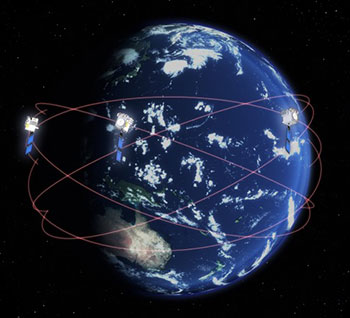
Global Observing Systems Analysis (GOSA)
We Test New Ideas!
Mission
The mission of the Global Observing Systems Analysis (GOSA) Group is to maximize and optimize current and future global observations to improve numerical weather prediction forecast skill in NOAA’s models. This includes algorithm development, management, and science support.
One of the primary goals of GOSA is to quantitatively evaluate the complementarity of different observing systems through Observing System Simulation Experiments (OSSEs) and Observing System Experiments (OSEs) to help NOAA management prioritize mission designs in a cost-effective way in support of the Quantitative Observing System Assessment Program (QOSAP).

COSMIC-2/Formosat7 Constellation - a constellation of twelve remote sensing microsatellites to collect atmospheric data for weather prediction and for ionosphere, climate and gravity research
Why is GOSA so important?
OSSEs save the taxpayer money because they allow us to analyze tradeoffs in the design and configuration of proposed observing systems (e.g. coverage, resolution, accuracy and data redundancy).
Research Areas
OSEs and OSSEs
The GOSA Group conducts Observing System Experiments (OSEs) and Observing System Simulation Experiments (OSSEs) to evaluate how new observations could improve our understanding of the Earth’s atmosphere. These experiments help identify cost-effective observing system solutions for the nation before they are even built and deployed.
- An OSE allows the evaluation of real data, but cannot be used to analyze the impact of future observing systems.
- An OSSE simulates observations made by planned instruments on future observing platforms before anything is built or deployed. Numerical forecast models can be operated with and without the new simulated data. Differences in the forecast performance can tell us the impact of new data.
Radio Occultation (RO) Technology
The GOSA Group leads NOAA research using Radio Occultation (RO) data as input to global and regional weather forecast models. The RO technology indirectly measures temperature, pressure, and water vapor in the atmosphere using rays connecting a Global Navigation Satellite System (GNSS) transmitter and a Low Earth Orbit (LEO) satellite. RO soundings are ranked as one of the top contributors in improving global forecasting skill.
Unmanned Aircraft Systems (UAS): SHOUT Program
Through OSEs and OSSEs, GOSA evaluates and tests targeted observations using Unmanned Aircraft Systems (UASs) to collect atmospheric observations and other crucial environmental information to assist weather predictions of high-impact weather. GOSA is a key participant of the SHOUT (Sensing Hazards with Operational Unmanned Technology) Program.
Read more about the UAS SHOUT Program
NOAA management has approved the Global Hawk/SHOUT participation in the ENSO Rapid Response Mission, with flights beginning nominally on 1 Feb 2016. GOSA will be providing primary guidance in mission targeting and planning.
Ground-Based Global Positioning System
The GOSA Group leads NOAA research of ground-based GNSS technology. If a GNSS receiver is placed on the surface of the Earth, rather than in a Low-Earth Orbit satellite, very precise time-series of precipitable water estimates can be derived at the location of the receiver. These observations can be assimilated in operational weather models to improve analyses and forecasts, particularly of the moisture field. GOSA is leading work on the assimilation of ground-based products with global coverage (e.g. zenith total delay, a less retrieved product than precipitable water) in NOAA’s operational global models.

The GOSA Team takes a hike in the beautiful mountains near Boulder, CO.
Who We Are
Lidia Cucurull, GOSA Group Chief
Karina Apodaca - Atmospheric Scientist
Becky Carlson - GOSA Office Manager
Jason English – Atmospheric Scientist
Guoqing Ge – Atmospheric Scientist
Andrew Kren – Atmospheric Scientist
Ruifang Li – Computer Scientist
Tanya Peevey – Atmospheric Scientist
James Taylor - Atmospheric Scientist

